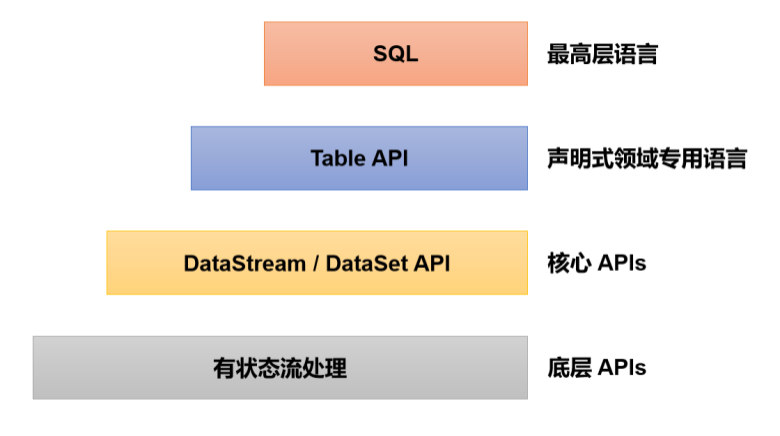Flink 处理函数(1)—— 基本处理函数
在 Flink 的多层 API中,处理函数是最底层的API,是所有转换算子的一个概括性的表达,可以自定义处理逻辑

在处理函数中,我们直面的就是数据流中最基本的元素:数据事件(event)、状态(state)以及时间(time)。这就相当于对流有了完全的控制权
基本处理函数主要是定义数据流的转换操作,其所对应的函数类为ProcessFunction
处理函数的功能和使用
对于常用的转换算子来说:
- MapFunction只能获取到当前的数据;
- AggregateFunction 中除数据外,还可以获取到当前的状态(以累加器 Accumulator 形式出现);
- RichMapFunction提供了获取运行时上下文的方法 getRuntimeContext();
但是无论那种算子,如果我们想要访问事件的时间戳,或者当前的水位线信息,都是完全做不到的
与时间相关的操作只能用时间窗口去处理,但如果要求对时间有更精细的控制,需要能够获取水位线,甚至要“把控时间”、定义什么时候做什么事,这就不是基本的时间窗口能够实现的了
因此需要使用处理函数:
- 处理函数提供了一个“定时服务”(TimerService),我们可以通过它访问流中的事件(event)、时间戳(timestamp)、水位线(watermark),甚至可以注册“定时事件”
- 处理函数继承了
AbstractRichFunction抽象类,所以拥有富函数类的所有特性,同样可以访问状态(state)和其他运行时信息 - 处理函数还可以直接将数据输出到侧输出流(side output)中
处理函数的简单使用:基于 DataStream 调用.process()方法就;方法需要传入一个 ProcessFunction 作为参数,用来定义处理逻辑:
stream.process(new MyProcessFunction())简单示例:
public class ProcessFunctionTest {public static void main(String[] args) throws Exception {StreamExecutionEnvironment env = StreamExecutionEnvironment.getExecutionEnvironment();env.setParallelism(1);env.addSource(new ClickSource()).assignTimestampsAndWatermarks(WatermarkStrategy.<Event>forMonotonousTimestamps().withTimestampAssigner(new SerializableTimestampAssigner<Event>() {@Overridepublic long extractTimestamp(Event event, long l) {return event.timestamp;}})).process(new ProcessFunction<Event, String>() {@Overridepublic void processElement(Event value, Context ctx, Collector<String> out) throws Exception {if (value.user.equals("Mary")) {out.collect(value.user);} else if (value.user.equals("Bob")) {out.collect(value.user);out.collect(value.user);}System.out.println(ctx.timerService().currentWatermark());}}).print();env.execute();}
}在 ProcessFunction 中重写了.processElement()方法(参数:输入,上下文对象,输出),自定义处理逻辑
ProcessFunction 解析
源码解析
源码如下:
public abstract class ProcessFunction<I, O> extends AbstractRichFunction {private static final long serialVersionUID = 1L;/*** Process one element from the input stream.** <p>This function can output zero or more elements using the {@link Collector} parameter and* also update internal state or set timers using the {@link Context} parameter.** @param value The input value.* @param ctx A {@link Context} that allows querying the timestamp of the element and getting a* {@link TimerService} for registering timers and querying the time. The context is only* valid during the invocation of this method, do not store it.* @param out The collector for returning result values.* @throws Exception This method may throw exceptions. Throwing an exception will cause the* operation to fail and may trigger recovery.*/public abstract void processElement(I value, Context ctx, Collector<O> out) throws Exception;/*** Called when a timer set using {@link TimerService} fires.** @param timestamp The timestamp of the firing timer.* @param ctx An {@link OnTimerContext} that allows querying the timestamp of the firing timer,* querying the {@link TimeDomain} of the firing timer and getting a {@link TimerService}* for registering timers and querying the time. The context is only valid during the* invocation of this method, do not store it.* @param out The collector for returning result values.* @throws Exception This method may throw exceptions. Throwing an exception will cause the* operation to fail and may trigger recovery.*/public void onTimer(long timestamp, OnTimerContext ctx, Collector<O> out) throws Exception {}/*** Information available in an invocation of {@link #processElement(Object, Context, Collector)}* or {@link #onTimer(long, OnTimerContext, Collector)}.*/public abstract class Context {/*** Timestamp of the element currently being processed or timestamp of a firing timer.** <p>This might be {@code null}, for example if the time characteristic of your program is* set to {@link org.apache.flink.streaming.api.TimeCharacteristic#ProcessingTime}.*/public abstract Long timestamp();/** A {@link TimerService} for querying time and registering timers. */public abstract TimerService timerService();/*** Emits a record to the side output identified by the {@link OutputTag}.** @param outputTag the {@code OutputTag} that identifies the side output to emit to.* @param value The record to emit.*/public abstract <X> void output(OutputTag<X> outputTag, X value);}/*** Information available in an invocation of {@link #onTimer(long, OnTimerContext, Collector)}.*/public abstract class OnTimerContext extends Context {/** The {@link TimeDomain} of the firing timer. */public abstract TimeDomain timeDomain();}
}
可以看到抽象类 ProcessFunction 继承了 AbstractRichFunction,有两个泛型类型参数:
I 表示 Input,也就是输入的数据类型;O 表示 Output,也就是处理完成之后输出的数据类型
其内部单独定义了两个方法:一个是必须要实现的抽象方法.processElement();另一个是非抽象方法.onTimer()
.processElement():用于“处理元素”,定义了处理的核心逻辑。这个方法对于流中的每个元素都会调用一次,参数包括三个:输入数据值 value,上下文 ctx,以及“收集器”(Collector)out。方法没有返回值,处理之后的输出数据是通过收集器 out 来定义- value:当前流中的输入元素,也就是正在处理的数据,类型与流中数据类型一致
- ctx:类型是
ProcessFunction中定义的内部抽象类Context,表示当前运行的上下文,可以获取到当前的时间戳,并提供了用于查询时间和注册定时器的“定时服务”(TimerService),以及可以将数据发送到“侧输出流”(side output)的方法.output() - out:“收集器”(类型为 Collector),用于返回输出数据。使用方式与 flatMap算子中的收集器完全一样,直接调用
out.collect()方法就可以向下游发出一个数据。这个方法可以多次调用,也可以不调用
.onTimer():用于定义定时触发的操作;这个方法只有在注册好的定时器触发的时候才会调用(在 Flink 中,只有“按键分区流”KeyedStream才支持设置定时器的操作),而定时器是通过“定时服务”TimerService来注册的- 参数:时间戳(timestamp),上下文(ctx),收集器(out)【这里的时间戳是指设置好的触发时间,在事件时间语义下就是水位线】
利用onTimer,可以自定义数据按照时间分组、定时触发计算输出结果,这样就实现了窗口的功能
处理函数分类
- ProcessFunction:最基本的处理函数,基于
DataStream直接调用.process()时作为参数传入 - KeyedProcessFunction:对流按键分区后的处理函数,基于
KeyedStream调用.process()时作为参数传入(要想使用定时器必须基于 KeyedStream ) - ProcessWindowFunction:开窗之后的处理函数,也是全窗口函数的代表。基于
WindowedStream调用.process()时作为参数传入 - ProcessAllWindowFunction:开窗之后的处理函数,基于
AllWindowedStream调用.process()时作为参数传入 - CoProcessFunction:合并(connect)两条流之后的处理函数,基于
ConnectedStreams调用.process()时作为参数传入 - ProcessJoinFunction:间隔连接(interval join)两条流之后的处理函数,基于
IntervalJoined调用.process()时作为参数传入 - BroadcastProcessFunction:广播连接流处理函数,基于
BroadcastConnectedStream调用.process()时作为参数传入(这里的“广播连接流”BroadcastConnectedStream,是一个未 keyBy 的普通 DataStream 与一个广播流(BroadcastStream)做连接(conncet)之后的产物) - KeyedBroadcastProcessFunction:按键分区的广播连接流处理函数,同样是基于
BroadcastConnectedStream调用.process()时作为参数传入(这时的广播连接流,是一个KeyedStream与广播流(BroadcastStream)做连接之后的产物)
学习课程链接:【尚硅谷】Flink1.13实战教程(涵盖所有flink-Java知识点)_哔哩哔哩_bilibili
